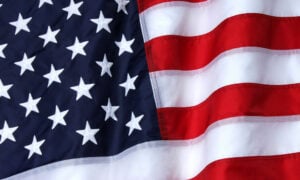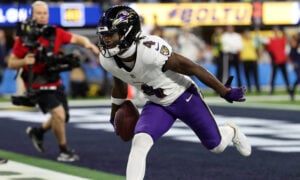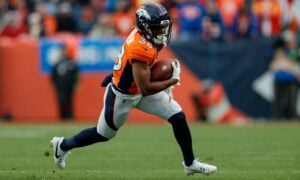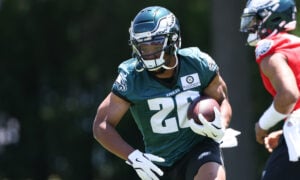Dynasty Fantasy Football Mailbag: A Heavyweight Young Receiver Trade

Welcome back to the DLF Mailbag, the preeminent mailbag in all the dynasty fantasy football land. As a reminder, there are multiple ways to pose your burning questions! I’ll be soliciting weekly feedback via X/Twitter (look for a new pinned tweet each Monday), and you can also reach out using our Discord channel, or the old-fashioned way (via our online webform).
With the changing of the calendar to July, we are now officially in the month when training camps begin! Per the NFL’s schedule, first up are the Baltimore Ravens rookies, who report on July 13. This will trickle into the coming weeks, with most veterans reporting around 10 days later. Both in advance of these dates as well as during, make sure you’re paying attention to DLF’s continuous updates and prognostications!
Let’s get to it!
From Discord…
All S(ain)t’s Day?
Which side do you prefer in a 12-team, superflex league – Amon-Ra St. Brown and a 2026 second-round pick, or Chris Olave, DeVonta Smith and a 2026 third-round pick?
This is a heavyweight trade, with both St. Brown and Olave being selected (on average) in the WR1 tier, and Smith a bit further down as a mid-range WR2 per the current DLF superflex ADP. Interestingly though, the superflex format serves to add a bit of separation among the players. St. Brown’s value gets dinged a bit, but he’s still going in the early second round. Olave is now a late third-round pick (versus an early second-round pick in 1QB formats), and Smith is going off the board just outside the fourth round, nearly doubling his 1QB ADP.
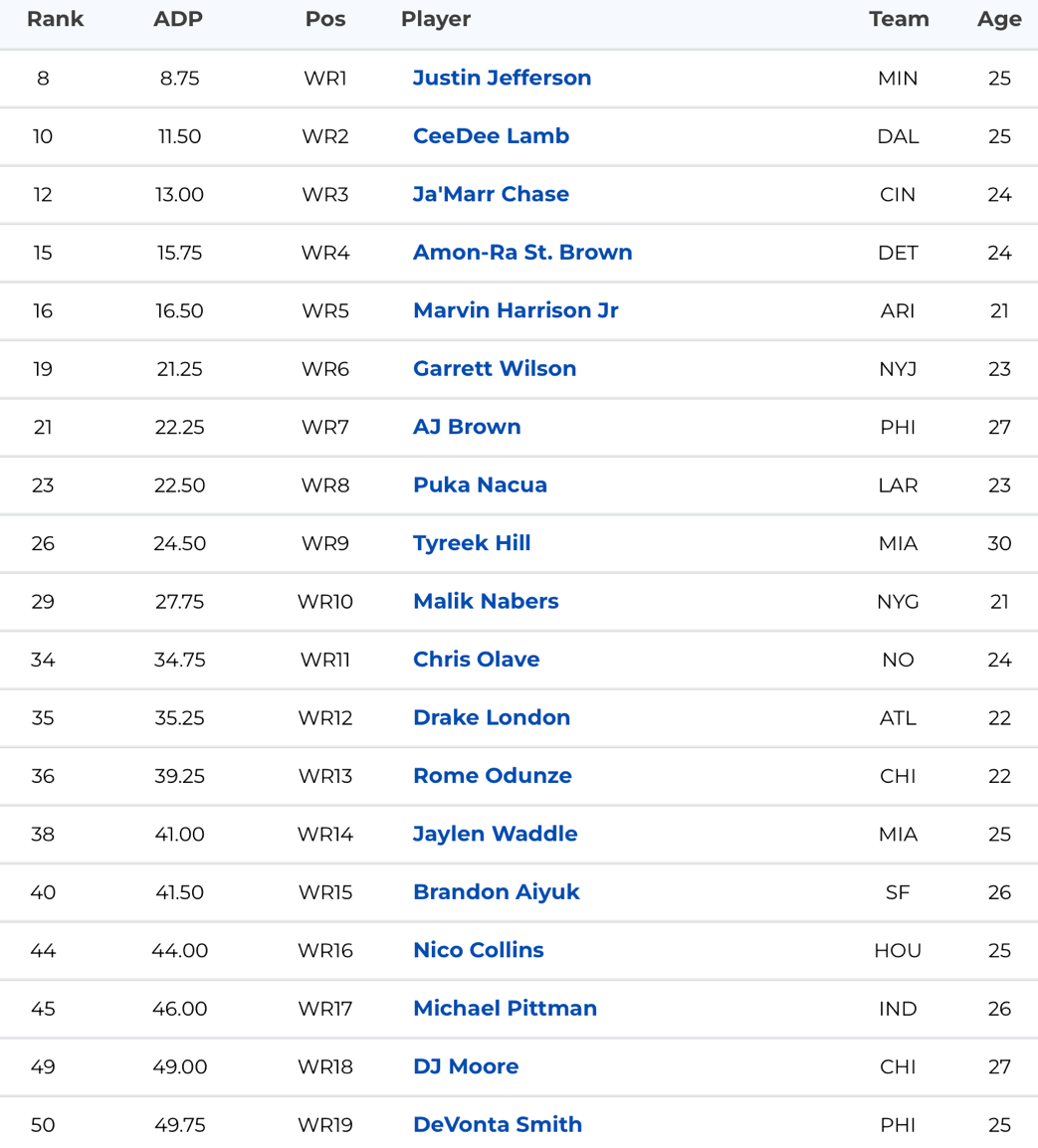
This is both interesting and important – we know quarterbacks gain significant value in a superflex or 2QB setting, but we must also remember that a startup draft represents a zero-sum game. If a pick is used on one player, it cannot possibly be used on another player. Put another way, if some players go up, others must go down. And while many signal callers have zipped past this trio of pass catchers, only 11 are going before St. Brown, as compared to 17 for Olave and 20 for Smith.
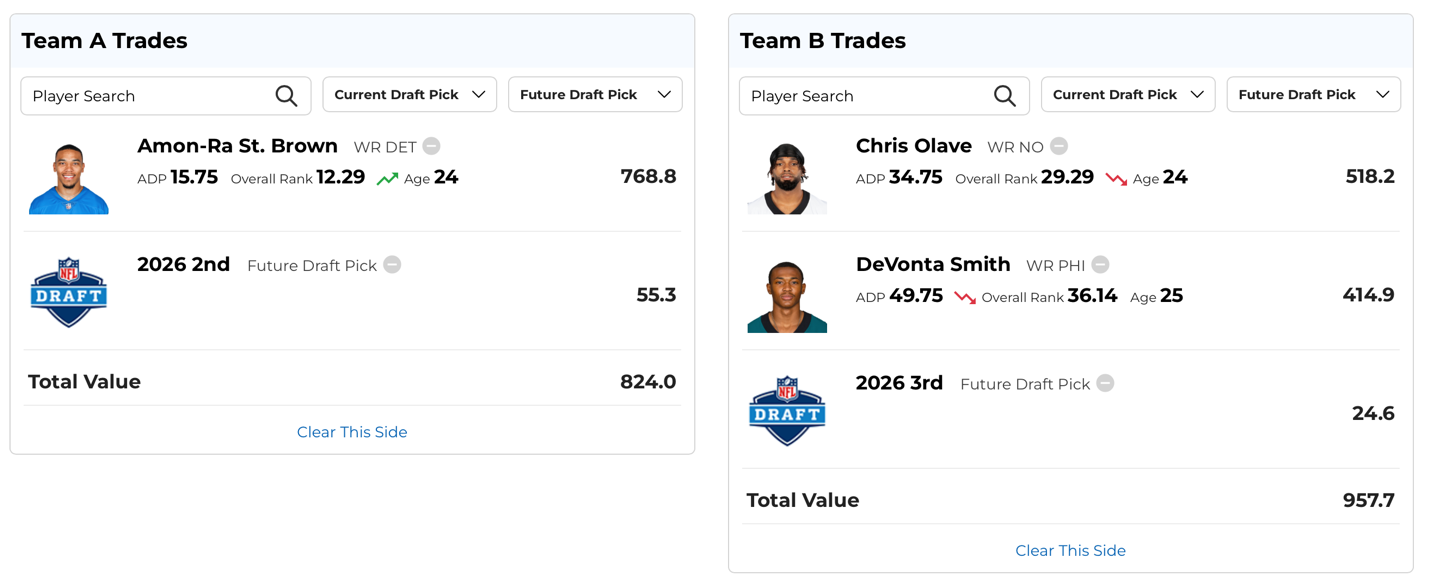
Still, the scale appears to tip towards the package deal. The righthand side contains the second and third best assets in the deal, though it’s worth noting these are approximately 67% and 54% of St. Brown’s worth, respectively. To conclude these preliminary remarks, I’ve included the picks for completeness, but to perpetuate my familiar refrain I’m not going to really worry about the theoretical future value of non-first rounders that are still two years away from bearing fruit.
I’ve stipulated previously in this space that the squad seeking the best player in the deal via packaging up is typically going to have to overpay. And while given his youth and proven skill St. Brown should be a fit on any type of roster, the other side of that coin is certain teams could benefit by trading away some of their best assets. Reasons could include but are not limited to:
- A perceived need to bulk up on depth in a team’s starting lineup
- A belief that they’re selling the high-value asset at the right time
- A belief that they’re buying low on the lower-tiered assets
In some instances, it could be a conflation of multiple reasons. In thinking through the above, in the case of St. Brown, the second bullet would be a tough sell. He’s improved each year in the league, ultimately resulting in career highs for every relevant pass-catching metric in 2023, when he finished as the PPR WR3. He also just received a big money contract, and at the time of this writing is the third-highest paid receiver in terms of yearly average value ($30.002 million annually). He’ll also continue to be paired with quarterback Jared Goff, who similarly received a top-dollar extension and is signed with the Lions through the 2028 season.
So let’s look instead to the likelihood of Olave and Smith being able to provide a larger proportion of St. Brown’s expected points moving forward. In order to do so, a sensible enough approach is to conduct something of an extremely truncated SWOT (strengths, weaknesses, opportunities, threats) analysis for each.
Olave
- Strengths: Great, if not elite speed, which is leveraged to command air yards and deep targets. Able to play both inside and outside and achieve above-average separation.
- Weaknesses: Smaller frame and lack of burst diminishes catch radius, yielding a below-average contested catch rate. Not a big touchdown scorer.
- Opportunities: Legitimately the only show in town in New Orleans, which has produced an elite target share to date.
- Threats: His own quarterback and coaching staff combine to result in an uncreative offense with low to average quality targets.
Smith
- Strengths: Proven collegiate ability to compile production and score touchdowns. Plays both inside and outside, and rarely drops passes.
- Weaknesses: Extremely slender frame. Has not shown an ability to excel in any one area, and through three years has been capped as a second-tier asset at the position.
- Opportunities: He’s a near full-time player with 100% route participation. Despite the presence of other elite talent on the team, he has still secured an above-average target share. Targets are also of above-average quality.
- Threats: Teammate AJ Brown is an elite receiver, and Dallas Goedert is a very good tight end. Quarterback Jalen Hurts siphons off a number of scores on the ground.
Rational minds may differ, but I’m struggling to see a universe where either player breaks out significantly past their current ~1,200-yard ceiling. While St. Brown has improved each year and established himself as an alpha pass catcher, Olave and Smith haven’t yet shown quite the same level of progress. If I had to guess, of the two Olave has a better chance as his numbers picked up last season, whereas Smith saw a downturn in production, but I’m not personally bullish on either pushing to the next tier.
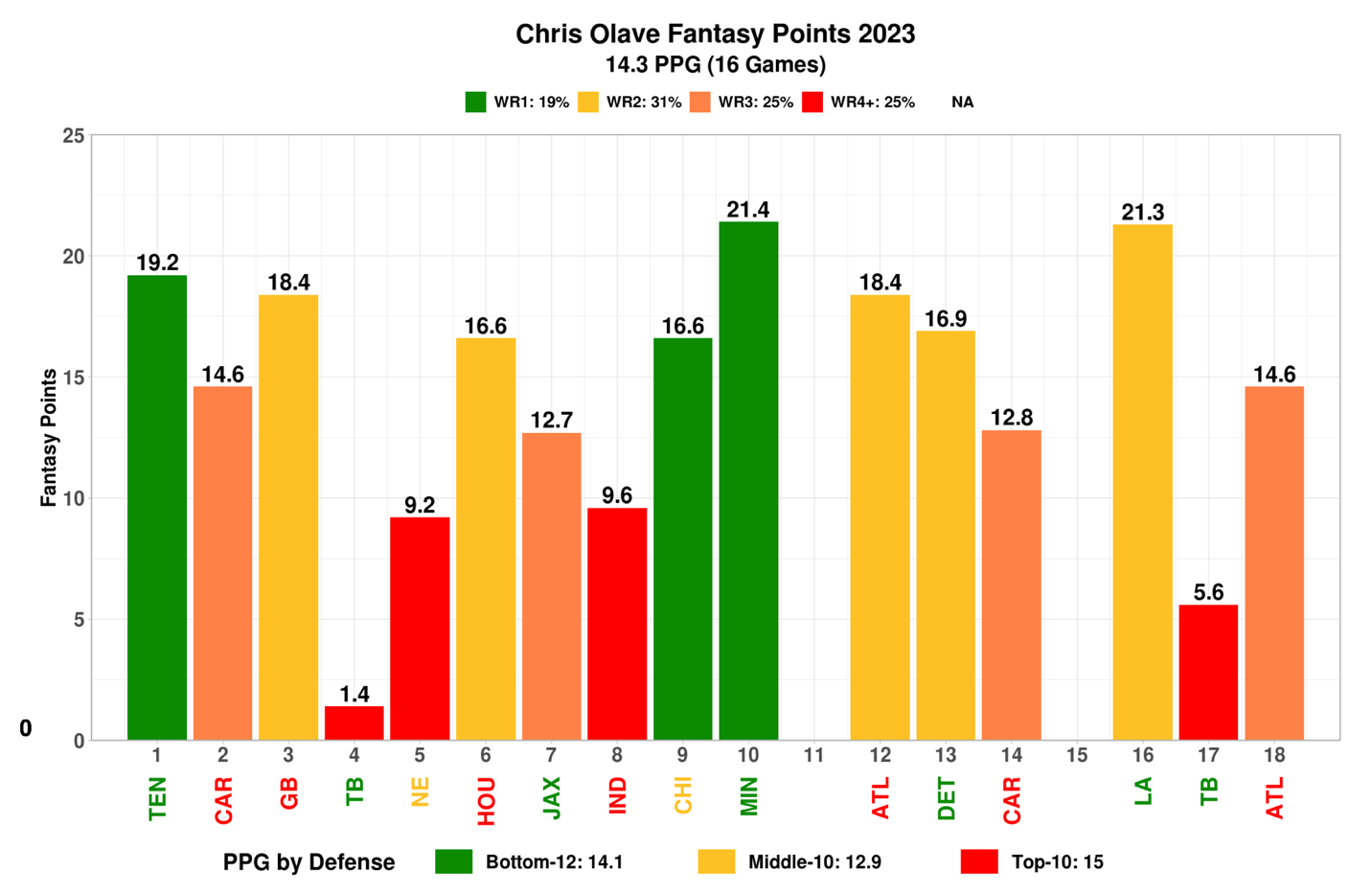
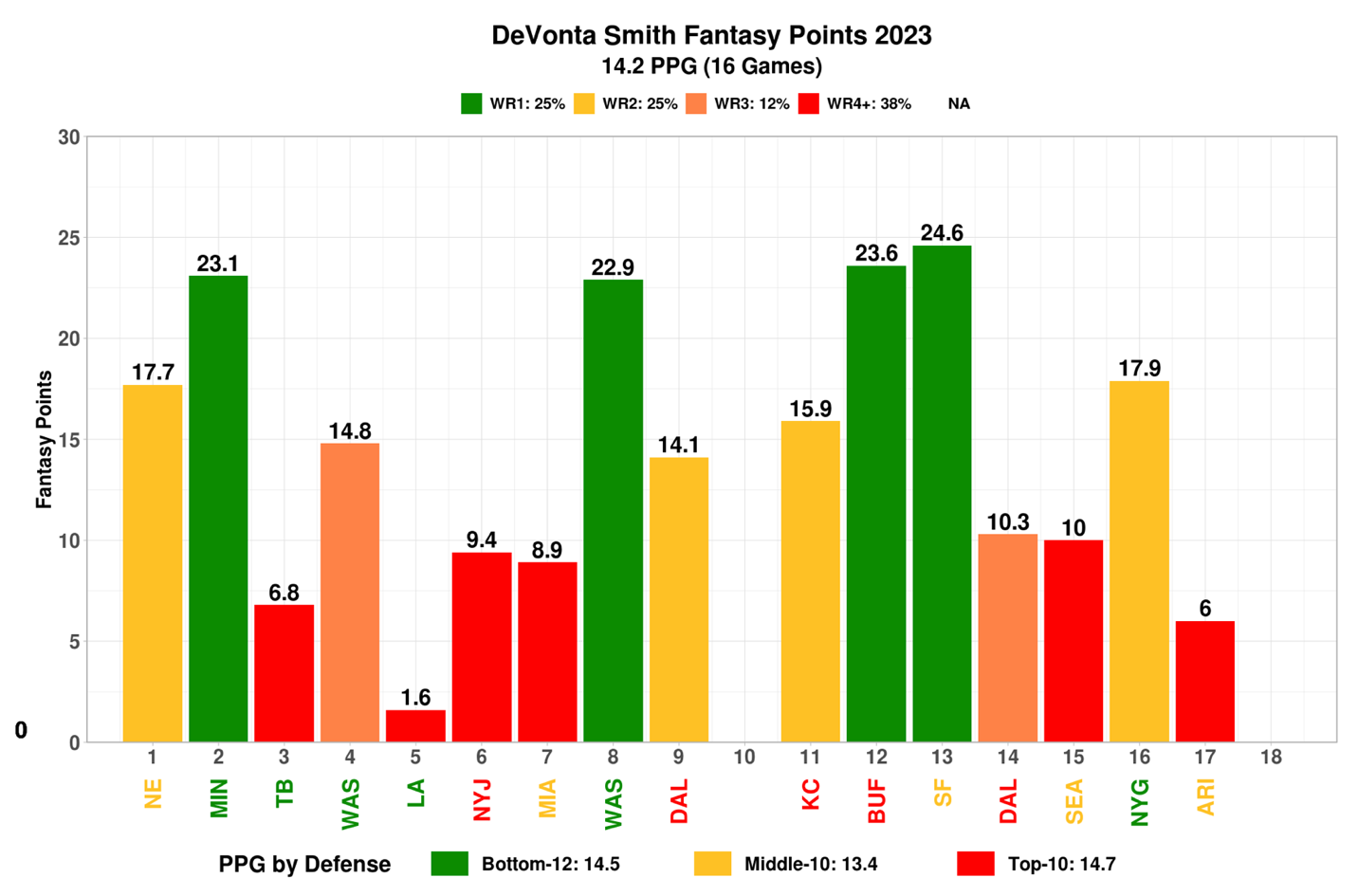
The 2023 numbers largely bear this out. Olave’s ceiling was not terribly high, with only three WR1 games and two games over 20.0 PPR points. Instead he functioned as more of a floor player, with only four games in the WR4 or worse tier, and eight games between 14 and 20 PPR points. There is something to be said for a player who will rarely if ever lose weeks for you, but this speaks more to depth than to demonstrably improving your starting lineup.
On the other hand, while Smith showed a similarly uniform “stoplight” pattern of weekly efforts (50% apiece of WR1/2 and WR3/4+ weeks), he was significantly more divergent with highs and lows. To the former, the Eagle’s peaks resulted in four games of at least 22.9 PPR points. To the latter, there were seven weeks of 10.3 PPR points or fewer. Unlike with Olave, Smith likely won a couple of weeks – but also unlike Olave he didn’t provide nearly as safe a floor.

In comparison, St. Brown is a unicorn. 62% of his games were WR1 efforts, and 81% were WR2 or better. There was only one instance of him scoring fewer than double digits, whereas all but three games resulted in at least 16.6 PPR points. To put that in perspective, this 16.6 PPR point mark is over two points more than Smith’s or Olave’s yearly average, meaning that, more or less, his floor was superior to their status quo. He also put an exclamation point on the season, averaging 25 PPR PPG during the fantasy playoffs.
So while I’m not going to call the DLF Trade Calculator out as providing any sort of fuzzy math, it’s a lesson as always that both nuance and context are important. On the aggregate, it may very well be more valuable to have two players with low-end WR1 / high-end WR2 ceilings in your lineup, as opposed to perhaps St. Brown and a lower-tier guy. But there is more depth at receiver than at every other position in fantasy football – to put that in perspective, if you combined the average weekly outputs of St. Brown and players such as Curtis Samuel, Josh Downs, Darius Slayton, Tyler Boyd or Jerry Jeudy, they would actually eclipse the average weekly total of Olave and Smith. While I recognize this is a blunt force argument meant more to shock, the point remains valid. St. Brown is such a game changer that it means solidifying the depth on the back end of your roster becomes less critical.
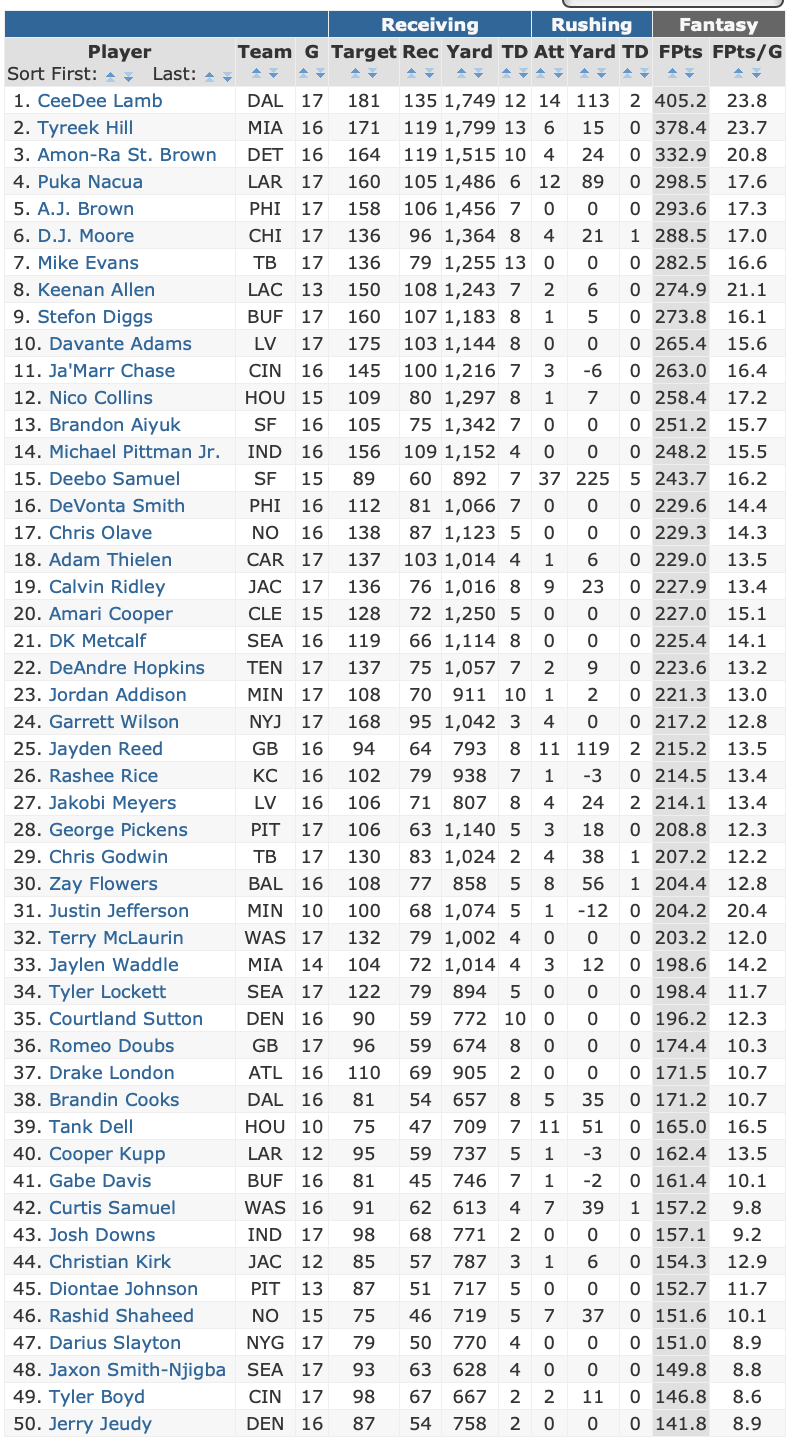
Statistics courtesy of FFToday.
So even though it would seemingly fly in the face of value, I’m taking the St. Brown side of this exchange. If I’m trading away an elite asset without receiving one in return, I would need to be overwhelmed by ancillary pieces. This likely sounds like a pejorative connotation, and I’m not trying to mitigate the values of Olave and Smith, who are indeed solid assets and startable players – but they’re not game changers, which means I’d feel a lot more comfortable having three solid assets or a better pick which has the potential to turn into one.
It might mean that for me, a deal might not be able to be struck, and it could come across as massive dynasty overreach. But underselling top-tier assets for pieces who don’t ascend as hoped is quite possibly the quickest way to dig yourself into a dynasty hole. You should feel convicted that the perceived benefit has a real path towards becoming tangible, not just that you’re getting good value.







